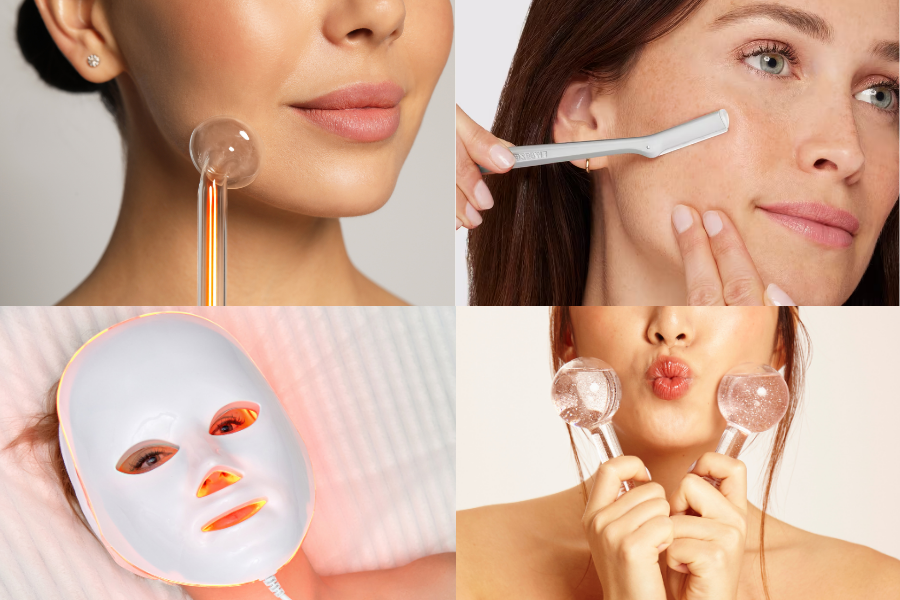
At-Home Skincare Tools: What Works and What to Avoid
Share
With the rise of at-home skincare tools, many people are now experimenting with treatments that used to be reserved for professional settings. Devices like LED masks, facial rollers, microcurrent tools, and even at-home dermaplaning kits are readily available, but are they effective—and more importantly, are they safe to use at home? In this guide, we'll cover some of the most popular at-home skincare devices, share insights on their effectiveness, and discuss when it might be better to consult a professional.
1. LED Masks: Brightening and Balancing
What It Does:
LED masks use different light wavelengths to target specific skin issues. Blue light is commonly used to target acne-causing bacteria, while red light aims to reduce inflammation, stimulate collagen, and improve overall skin texture.
Does It Work?
Yes, to an extent. LED masks can be beneficial for certain skin issues if used consistently, but at-home versions are generally less powerful than those used in professional settings. The results may be gradual, requiring daily or several times a week use to see any difference.
When Professional Treatment Is Better:
For deeper skin issues like severe acne or pronounced wrinkles, a professional LED treatment can be far more effective due to the strength and customization options of clinical-grade devices. An esthetician can adjust the settings to provide targeted, more intensive results in a shorter time frame.
What It Does:
Typically made of materials like jade or rose quartz, facial rollers are designed to stimulate blood flow, reduce puffiness, and aid lymphatic drainage, which can give the skin a more toned and refreshed look.
Does It Work?
Facial rollers can be effective for temporary de-puffing, especially when chilled before use, and may provide a calming ritual for some. However, they won’t drastically change skin texture or firmness. With that being said, If you are using these types of tools for inflammation, like acne or rosacea, they can be super effective! Any cold compress, whether that's from putting your tool in the fridge or just using a piece of ice, can reduce inflammation greatly!
When Professional Treatment Is Better:
If you’re looking for more noticeable firming and lifting, microcurrent facials or treatments like radiofrequency, performed by an esthetician, are far more effective. These professional treatments penetrate deeper layers of the skin, providing longer-lasting and visible results.
3. At-Home Dermaplaning Kits: Smoothing and Exfoliating
What It Does:
At-home dermaplaning kits use a small, fine blade to remove dead skin cells and fine facial hair, leaving the skin smooth and primed for better product absorption.
Does It Work?
If done carefully, dermaplaning can provide a smoother surface and may improve the skin’s overall texture. However, improper technique & cheap tools that have jagged blades, can lead to irritation, nicks, and even infection.
When Professional Treatment Is Better:
Professional dermaplaning performed by an esthetician is safer and provides a more thorough exfoliation without the risk of damaging the skin. Estheticians use sterilized, single-use blades and are trained to avoid sensitive areas, making the treatment far safer and more effective.
4. Microneedling Devices: Collagen Boosting
What It Does:
Microneedling devices create tiny punctures in the skin, which stimulates the body’s wound-healing process and can boost collagen production.
Does It Work?
At-home microneedling devices have a higher risk for adverse reactions and scarring. For example, Dermarollers can incorrectly penetrate the skin & cause scars or hyperpigmentation. They also won’t significantly stimulate collagen in the way professional microneedling does. This can be dangerous & we would strongly recommend against doing this at home.
When Professional Treatment Is Better:
Professional microneedling penetrates deeper layers of the skin, delivering real benefits for scarring, pigmentation, and aging concerns. Estheticians can also combine microneedling with other serums or treatments to amplify results, which isn’t possible with at-home devices. Plus the safety factor is a huge benefit.
5. High-Frequency Wands: Spot-Treating Acne
What It Does:
High-frequency wands use a mild electrical current to treat acne, kill bacteria, and reduce inflammation.
Does It Work?
High-frequency treatments can help reduce redness and the size of active breakouts if used correctly. However, effectiveness can vary, and improper use can lead to burns or irritation. Overall, with at home high-frequency wand devices are typically safe due to their mild strength.
When Professional Treatment Is Better:
Estheticians use more advanced high-frequency devices and apply them in combination with other treatments suited to your skin type. This targeted approach, along with professional-grade equipment, makes the treatment much safer and more effective.
Key Takeaways
While at-home devices can complement a skincare routine, they often provide more subtle results compared to professional treatments. When it comes to tools like microcurrent devices, LED masks, and microneedling kits, results may vary, and improper use can lead to irritation or even injury.
For anyone looking to address specific skin concerns or seeking faster, longer-lasting results, a consultation with an esthetician can be invaluable. Estheticians have access to professional-grade equipment and are trained to provide safe, effective treatments tailored to your unique skin needs. So, while at-home tools can be a fun addition to your skincare routine, there’s no substitute for professional care when you want real, noticeable change.
Final Note
If you’re curious about how professional versions of these tools can improve your skin, don’t hesitate to reach out to your esthetician! They can provide guidance on when and how to use at-home tools safely and help you decide if a professional treatment might be a better choice for your skin goals.